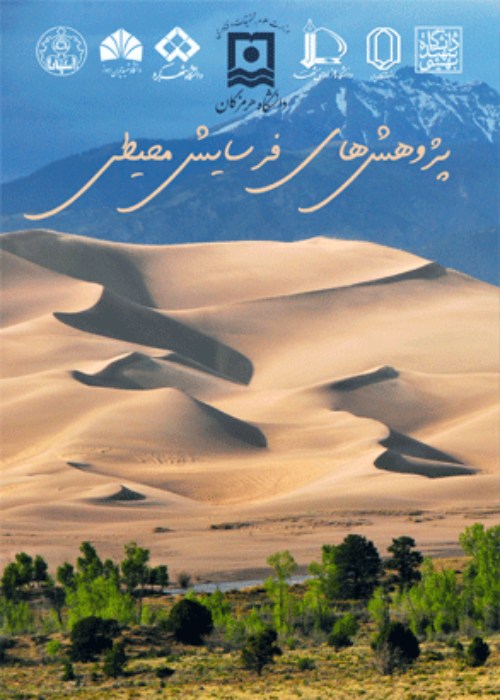Identifying Dust generation potential sources using fuzzy logic in Hamadan province
Dust is a term used in meteorology to refer to very small, solid, light particles of silt, clay, or sand created by wind erosion and desertification. It is transported over long distances. Dust is more common in arid and semi-arid lands, which is related to the climatic characteristics of these areas and has become one of the main problems in these arid areas. Studying the effects and consequences of this phenomenon, as well as proper management to reduce the effects of dust and focusing on areas which are the origin of the storm can be important in identifying areas as the source of dust. In other words, proper identification of dust sources is of great importance due to its impact on the environment. Soil erosion is the most important cause of dust, and the most important parameters for soil erosion include vegetation, soil moisture, surface roughness, and land use.
To identify the potential of dust generation in areas of Hamadan province and the effected ranges, a multi-criteria evaluation method was applied. Land use information, vegetation, roughness, and soil moisture were extracted from the Landsat 8 (OLI) and Landsat 5 (TM) images for three periods of 2001, 2009 and 2018. Images were corrected radiometrically. ENVI 5.3 software was used to correct the radiometric and atmospheric images. All of the layers were standardized to a range of 0-255 as a fuzzy method. to standardize the land use layer, the user-defined function was used and fallow and uncultivated lands were given a value of 255 while, 150 to low-density pastures, 95 to fallow grounds, 75 to dryland farming, 25 to built-up areas, 6 to Mountain and rocky outcrop, 3 to gardens, 2 to irrigated agriculture and zero value to snow and water cover. The NDVI index was used to extract the vegetation map and standardized using the Linear Symmetric function. the soil moisture index was obtained by the NDMI index, and Linear Monotonically decreasing function was applied to standardization this layer. The surface roughness coefficient was extracted from ASTER imagery and a Linear Monotonically decreasing was employed to standardize this layer. The WLC approach was applied to integrate the above criteria. According to expert choice, the humidity score is 5 compared to vegetation cover, humidity to roughness is 7, moisture to land use is 9, vegetation to roughness is 3, vegetation to land use is 5 and roughness to land use is 3. Then the fuzzy maps of the area were merged so that higher values and closer to 255 meant more desirability as dust sources and lower values meant less desirability. Finally, to select the potential hotspots, using the dust output desirability image, the threshold levels were adjusted based on the threshold.
The results showed that the incompatibility rate from the comparisons made between the factors was estimated to be 0.66, which is acceptable. The final map of possible dust sources was prepared based on utility levels using threshold values for 2001, 2009 and 2018. By contractually dividing the suitability map into 5 classes based on the threshold, areas with the highest potential (255-225), high potential (225-200), medium potential (150-200), low potential (150-100) and lowest potential (100-0) were identified and the 5th category (255-225) was selected as the most likely sources. The soil erosion map was then overlaid with the dust hotspot map and the result showed that of the total 227,483 hectares of land identified as dust hotspot, 121023 hectares are located in lands with catastrophic erosion, 56956 hectares in lands with extraordinary erosion, 17718 hectares in lands with Extreme erosion and 24272 hectares in lands with high erosion, respectively. In other words, more than 96 percent of the identified hotspots are situated in areas with moderate erosion and higher.
The results of this study showed that four-defined factors including soil moisture, vegetation, land surface roughness, and land use type can have a high ability to identify potential dust sources. Overlaying identified areas with erosion maps, which show an overlap of about 97 percent between these sources and areas with above-average erosion, confirms this fact that the main internal sources of dust are due to soil degradation on lands. Accordingly, the lack of proper management can change these potentially identified areas to actual dust production centers. Therefore, it is necessary to plan protection programs to prevent dust storms such as planting vegetation around the borders of the province or county and to prevent pasture overgrazing.
Soil Erosion , Dust , Source , Fuzzy Logic , Hamadan
- حق عضویت دریافتی صرف حمایت از نشریات عضو و نگهداری، تکمیل و توسعه مگیران میشود.
- پرداخت حق اشتراک و دانلود مقالات اجازه بازنشر آن در سایر رسانههای چاپی و دیجیتال را به کاربر نمیدهد.



